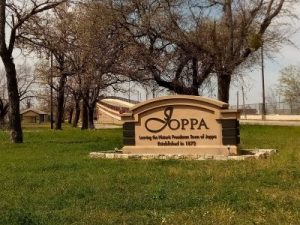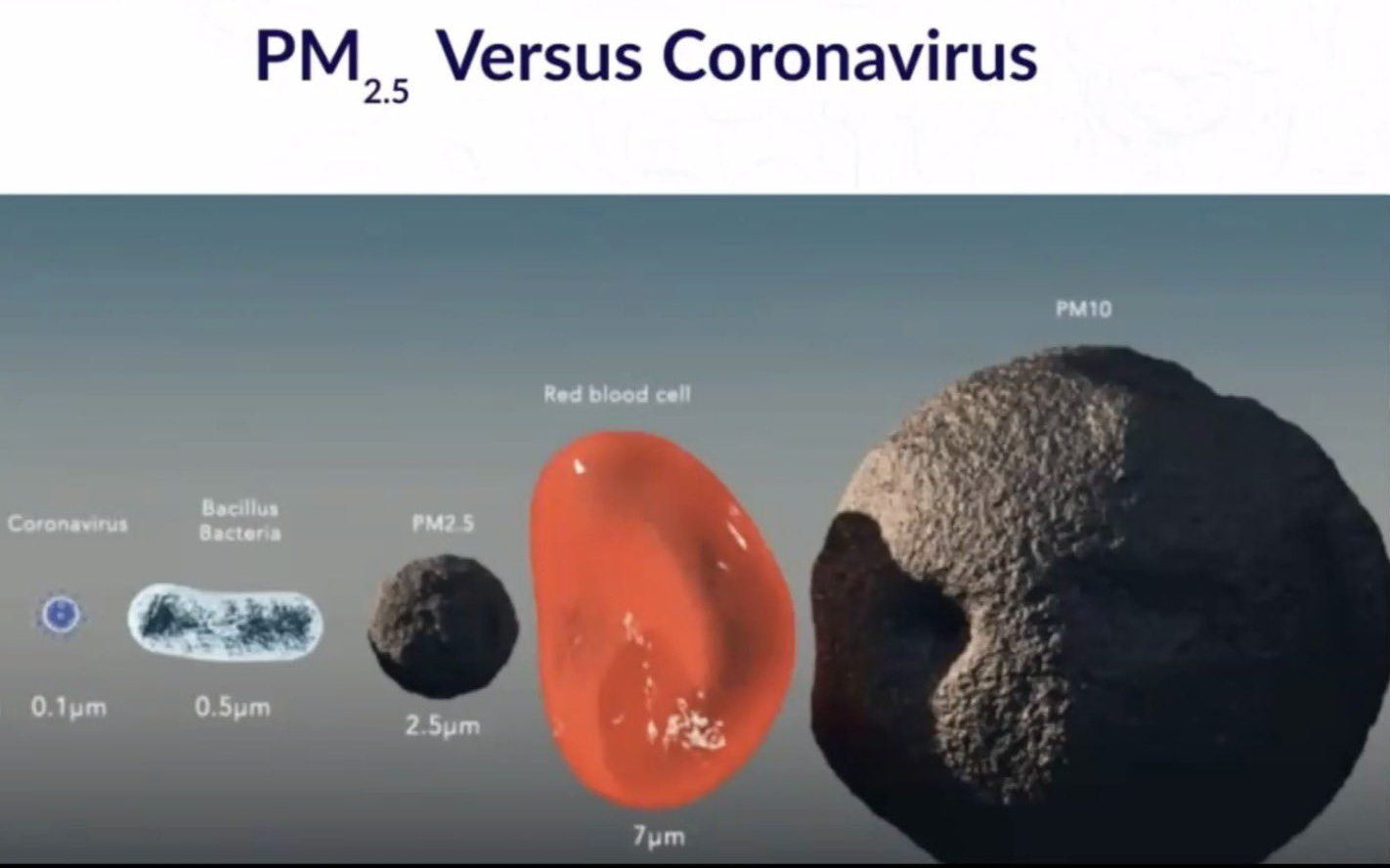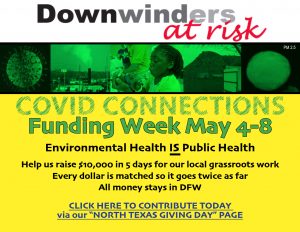Citizen Science
Meet the new Downwinders at Risk

Dallas Morning News Consumer Watchdog columnist Dave Lieber found himself listening in on the annual “State of the Air” presentation we’re always invited to give at the Arlington Conservation Council. Lots of information about smog and PM pollution but what really got his attention was the description in the Q&A about the wholesale transformation of Downwinders’ mission and board since 2017. He was so impressed he decided to write about it for his next column. Here’s the flattering result with some great pics our Chair Evelyn Mayo, our founder Sue Pope and (almost) our complete board as of August 2021. Thanks to Dave for the coverage and to all of you for supporting us through this transition.
For those without a DMN subscription we’re reprinting the entire article below:
Top anti-pollution group gets a makeover to an all-women board with young adults and people of color
Most nonprofit boards can only dream of bringing in younger members and people of color to reflect their communities. This one did it.
The phrase “trophy wall” caught my attention.
Jim Schermbeck, the wise old battler against Dallas-Fort Worth air pollution for the last quarter century, was bragging about his group’s new generation of leadership and its new focus on protecting neighborhoods.
I was in a webinar listening to Schermbeck, program director for pollution fighter Downwinders at Risk, as he gave an overview of our air quality (it’s bad!) when the trophy wall thing perked me up. It had something to do with Dallas City Hall officials leaving their jobs. Forgive the gruesome image, but the symbolism was that their heads were hung up on a wall.
I turned up the volume on my computer so I could hear.
He told a story about how the city of Dallas in recent years had allowed two northern Dallas neighborhoods to create their own land use plans. But when two southern Dallas neighborhoods tried to do the same, they were told by the city that neighborhood-based land use plans created by community members were no longer acceptable.
Putting it bluntly, white neighborhoods were allowed to create bottom-up plans that were presented to and accepted by city officials. But these neighborhoods where people of color live were forced to accept top-down plans imposed upon them by City Hall.
Schermbeck mentioned the group’s chair, Evelyn Mayo, a 26-year-old firebrand, and said, “This made her mad.”
Mayo helped organize several groups into the Coalition for Neighborhood Self-Determination, which agitated for fairness in community-created land use plans. Letters were sent to Dallas Mayor Eric Johnson, the City Council and City Manager T.C. Broadnax.
/cloudfront-us-east-1.images.arcpublishing.com/dmn/VHF2H4PGCBFPHDLIWRBDDDUSFU.jpg)
The power play appears to have worked. Three zoning officials decided to retire from the city. They are: Peer Chacko, the city’s director of planning and urban design; David Cossum, development services administrator; and assistant zoning director Neva Dean.
Kris Sweckard, the director of sustainable development and construction, was reassigned to the city’s aviation department on an interim basis.
“So at age 26, this woman has a department head on her trophy wall for a good cause,” Schermbeck was saying. “It’s just amazing to watch. If you ever think young people are not with it, and you want to build your confidence back up about people, please come to a board meeting or hang out with Evelyn and her friends for a while. They will restore your confidence about where we’re headed. She’s an amazing person, and our board is really great.”
/cloudfront-us-east-1.images.arcpublishing.com/dmn/A2SOKXOTI5HBBAGB6CVHNDCLJA.jpg)
Shine a spotlight
I asked Mayo how she felt about the trophy wall analogy. “I don’t think it’s something you should aspire to,” she said. “We were simply reacting to circumstances presented before us.”
Later, she toughened it up a bit, saying: “Whether it’s a trophy wall or not, what’s happening at City Hall is a product of their own incompetence.”
Downwinders board member Misti O’Quinn told me that the coalition shined a spotlight on one portion of neighborhood zoning, and when you shine a spotlight you can expose. What does that mean for city officials? “You take away their sense of security,” she said.
/cloudfront-us-east-1.images.arcpublishing.com/dmn/XOB66IBJRFCCPDQFPUCP7KZPLA.jpg)
I attempted to reach the four City Hall officials but was unsuccessful. When I ran this scenario up the flagpole to Broadnax, he provided a written statement to The Watchdog explaining that when several staffers announced their intention to retire this year, it presented an opportunity to realign their departments.
“Over the next several months,” he said, “we intend to simultaneously restructure permitting and planning and realign the departments and leadership that oversee them. Reorganizing these departments will maximize effectiveness and productivity.”
He made no mention of the coalition or its agitation.
Change with the times
This story runs far deeper than citizen agitation. Downwinders represents a model for how environmental and other nonprofits can alter their profile, their mission and their leadership.
As I looked at the group’s history, I saw how Downwinders has changed in recent years.
Formed in 1994 by Midlothian rancher Sue Pope and other rural residents and suburbanites, Downwinders’ mission for the longest time was fighting pollution caused by cement plants.
/cloudfront-us-east-1.images.arcpublishing.com/dmn/YOOOOF4INFGW5JU7KCBDVI6NUQ.JPG)
But by 2017, the year Mayo joined the board, it was becoming clear — thanks in part to the hideous Shingle Mountain dump site in southeast Oak Cliff — that Dallas needed a spotlight to focus on what activists and academics call historically racist zoning. That’s what allows dirty industries into poorer residential neighborhoods where people of color live. Correcting those inequities is called environmental justice.
In the next two years, the old guard board members, many of whom had served since the group’s creation, all dropped off. The board and its mission changed from rural/suburban to urban.
“It was very traumatic,” Schermbeck recalls. “But I’m so glad we did it because we’re more plugged in than ever before.”
Mayo says the worst moment came in 2019 when she was elected to the unpaid job of chair in what she calls “a somewhat contentious vote.”
The board is now all women; two are Asian-American, five are Black, two are Latina and three are white. Three members are in their 20s, and six are in their 30s. One member is 17 years old.
Most community nonprofits, especially in the traditional environmental arena, can only dream of putting together a board with that diversity.
Mayo, who teaches at Paul Quinn College, has a perfect resume for her leadership role. She majored in environmental science in college with a focus on race and ethnicity.
Working as a paralegal at Legal Aid of NorthWest Texas, she co-authored a study called “In Plain Sight,” which examined the governmental failures that allowed a disaster like Shingle Mountain to spiral out of control.
Then while teaching undergraduates at Paul Quinn, she and her students in 2020 completed a study – “Poisoned by Zip Code: An Assessment of Dallas’ Air Pollution Burden by Neighborhood.” You can guess the results of that survey.
The Downwinders’ main goal, in addition to continuing its legacy battle against dirty air, is to bring power and expertise to the city’s poorer neighborhoods that have had no say in dirty industries moving in.
/cloudfront-us-east-1.images.arcpublishing.com/dmn/3VRLM7INOFGSHGAAN667IY3NYI.jpg)
“The legacy of racist zoning perpetuates unless you fundamentally redraw the map through these land use plans,” she says. “People who are affected must be involved in the decision-making process about what their neighborhood will look like. This will probably have better outcomes for their health and wellness.”
Yet, she adds, “People who live there and bear the brunt of the pollution are still not at the decision-making table.”
Mayo says her group needs all the help it can get.
“No matter who you are, we can put you to work if you’re interested and willing,” she says.
Note: A tip of The Watchdog’s hat to Downwinders’ board members: Cressanda Allen; Satavia Hopkins; Misti O’Quinn; Essence Tetteh; Marsha Jackson; Cindy Hua; Amber Wang; Idania Carranza; Soraya Coli; Amanda Poland; Michelle McAdam; and Shannon Vorpahl.
We Did This: A Shingle Mountain Clean-Up is Coming
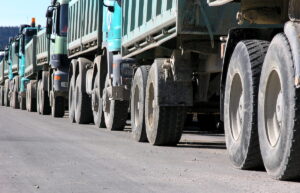
Despite the flurry of cynical and self-serving photo ops and press releases that Dallas City Hall churned out on Monday celebrating the beginning of a clean-up at Shingle Mountain, no waste was removed from the site yesterday. Nor will any be removed today.
But thanks to you, a clean up is coming. And also thanks to all you, that clean-up is suddenly more concerned with the health of Choate Street residents.
Last week, after a required 30-day public notice period, a state court approved a settlement between the illegal dump’s landowner, the State of Texas and the C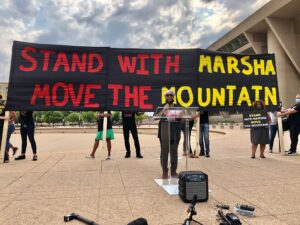 ity of Dallas that sets the table for removal of all “above ground” material. On Monday, contractors for the city were installing air monitors around the dump to record the levels of dust created when bulldozers begin loading the estimated 100,000 tons of hazardous waste into waiting 18-wheelers for the half mile trip to the McCommas landfill.
ity of Dallas that sets the table for removal of all “above ground” material. On Monday, contractors for the city were installing air monitors around the dump to record the levels of dust created when bulldozers begin loading the estimated 100,000 tons of hazardous waste into waiting 18-wheelers for the half mile trip to the McCommas landfill.
According to a separate agreement between the City and the landowner, the City has until December 25th to “begin” the removal process, i.e. sending trucks to actually haul off waste.
This result was anything but a foregone conclusion when the “Move the Mountain” campaign began last August 5th with a new conference at City Hall demanding the illegal dump be gone by the end of the year.
Only 4 months ago City Hall hadn’t made any commitments to a clean-up and had no estimate for when one would take place. The City Council had just unanimously rejected pleas from Choate Street residents to re-establish the Environmental Health Commission as part of a new Climate Plan. We were at a low ebb in our campaign.
But a strategic and constant barrage of public protest and shaming – mock trials, leafleting the Mayor’s law firm, 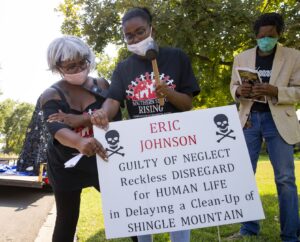 dumping waste at City Hall – along with the attendant embarrassing media coverage, made the City of Dallas actually commit itself to a clean-up it hadn’t planned on doing quite as fast, if at all.
dumping waste at City Hall – along with the attendant embarrassing media coverage, made the City of Dallas actually commit itself to a clean-up it hadn’t planned on doing quite as fast, if at all.
Keeping constant pressure applied for four months was often exhausting, but momentum grew with each new demonstration. November 16th might have seen “peak” Shingle Mountain coverage with publication of a long and well-written expose in the Washington Post, a public demonstration at the dump’s gate counting down the days until a clean-up was supposed to begin and a crew from Solodad OBrien’s upcoming BET documentary in town to film it for a premiere in February.
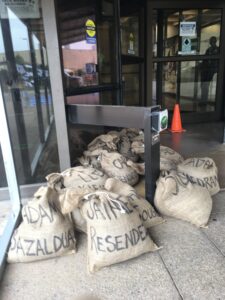 Thanks to everyone who showed up to those demonstrations of support. Whether you attended one or all of them, your presence made a difference.
Thanks to everyone who showed up to those demonstrations of support. Whether you attended one or all of them, your presence made a difference.
Those of you who sent in public comments this last month also had an impact. Initially, neither the State nor City expressed the least bit of concern about the health of Choate Street residents during the messy business of removing the waste. No specific provisions for controlling dust or monitoring air quality were included in the City agreement or State settlement.
But after over 50 letters and emails worth of comments were sent and included in the public record, the City suddenly got religion. It included dust control measures and air monitoring in its final description of the clean-up to the court. Lawyers for Marsha Jackson, Co-Chair of Southern Sector Rising, and a Downwinder board member cited your public comments as the reason the City included these new safeguards at the last minute. So congratulations a second time.
Now what?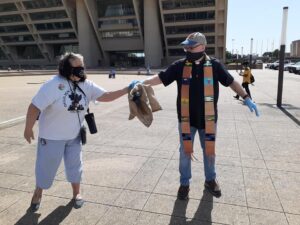
The settlement and agreements signed by the State and City are vague about what happens after the land surface is cleared of waste. Will there be any monitoring wells drilled to see if contamination seeped into the groundwater? Will the clean-up extend below the ground as well as above if the soil is contaminated? If pollution is found in the soil or water, what level of contamination is “acceptable”, i.e. what are the clean-up levels then?
And what and who will be responsible for the health costs -financial and physiological – accumulated by Ms. Jackson and the other Choate Street families?
Residents have drafted their own neighborhood plan for redevelopment that drastically changes the zoning in their community. They’ve submitted it to City Hall. But the same City Council Member that was taking unearned credit for Shingle Mountain’s removal on Monday is fighting this neighborhood plan tooth and nail.
District 8 City Council Member 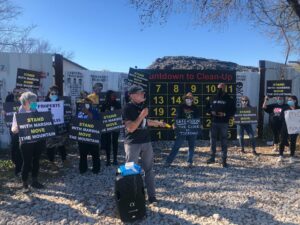 Tennell Atkins is one of the biggest reasons Shingle Mountain exists at all, and why its removal has been so delayed. He’s been nothing but an obstacle to be overcome instead of an ally for his constituents. Adding insult to injury, he’s now standing in the way of Choate Street and Flora Farms residents being able to rebuild their community from the devastation he’s inflicted on them.
Tennell Atkins is one of the biggest reasons Shingle Mountain exists at all, and why its removal has been so delayed. He’s been nothing but an obstacle to be overcome instead of an ally for his constituents. Adding insult to injury, he’s now standing in the way of Choate Street and Flora Farms residents being able to rebuild their community from the devastation he’s inflicted on them.
Atkins is up for re-election in May and it’s our hope that all of you who made this Shingle Mountain clean-up happen will stick around and finish the job by helping us remove this political tumor that threatens the future of Southern Dallas.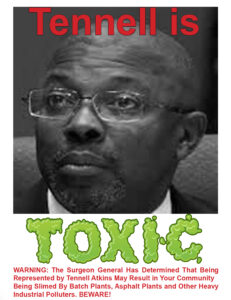
Sunday December 13th was the two-year anniversary of the very first Robert Wilonsky column about Shingle Mountain in the Dallas Morning News. Some of us believed that first column would expose the problem and move officials to act to resolve it. 13 Wilonsky Shingle Mountain columns later, we’re still waiting on the trucks that should have arrived in January 2019.
If they show up before Christmas Day , it will be one of the best, most satisfying moments of a terrible year. But it won’t be the end of the struggle over racist zoning that began on Choate Street. That struggle is just beginning.
Robert Wood Johnson Foundation awards grant to Texas A&M and Downwinders at Risk for Joppa Environmental Health Project
Monies will fund unprecedented study of link between health and air pollution in Dallas Freedman’s Town; first effort of its kind in Texas
What’s believed to be the single largest environmental health research investment in a Texas neighborhood was awarded today by the Robert Wood Johnson Foundation to examine the links between human health and air pollution in the Joppa community of Dallas.
 Texas A&M and Downwinders at Risk’s Joppa Environmental Health Project was selected as one of only 16 national proposals funded by the Foundation’s Interdisciplinary Research Leaders grant. Between now and 2022, over $350,000 will be spent by Texas A&M scientists trying to understand the correlation between Particulate Matter air pollution and the health of the Freedman’s Town’s residents.
Texas A&M and Downwinders at Risk’s Joppa Environmental Health Project was selected as one of only 16 national proposals funded by the Foundation’s Interdisciplinary Research Leaders grant. Between now and 2022, over $350,000 will be spent by Texas A&M scientists trying to understand the correlation between Particulate Matter air pollution and the health of the Freedman’s Town’s residents.
Cecilia Wagonner, a member of the Joppa church that hosted a community meeting on air pollution monitoring last December, was enthusiastic about the news. “I want to know the truth and nothing but the truth about air quality in our historic neighborhood. This is definitely good news. Let environmental justice be served.”
Per capita, Joppa is the most polluted neighborhood in Dallas. On one side is the Trinity River. On the other three sides are an asphalt batch plant, Railroad switch yard, large asphalt shingle factory, a concrete batch plant, and Interstate highway. It’s directly downwind from the largest methane air p olluter in Dallas – the City’s McCommas Landfill methane energy recovery unit.
olluter in Dallas – the City’s McCommas Landfill methane energy recovery unit.
Since PM air pollution monitoring began there on August 31st as part of the new SharedAirDFW air monitoring network, Joppa’s PM levels have averaged significantly higher than other sites.
Two Texas A&M scientists based in College Station will lead the new Project. Dr. Natalie Johnson, is an A&M toxicologist specializing in the health effects of Particulate Matter air pollution, and Dr. Ping Ma, is an A&M behavioral and social science researcher who previously worked at Dallas Children’s Hospital specializing in health disparities and social determiners of health. Downwinders will assist with community canvassing and outreach efforts as well as provide technical support through its 11-Joppa based SharedAirDFW network monitors.
They’re now all charged with collecting evidence to discover whether Joppa has higher rates of PM air pollution and health problems than other communities, and understand how differences in daily levels of PM affect residents’ health.
“PM represents a significant ‘unseen’ health risk related to cardiovascular disease, chronic respiratory disease, including lung cancer and asthma, as well as effects on infant development and brain health,” said Johnson. “SharedAirDFW’s real-time pollution monitors will help make this threat ‘seen.”
Ping pointed out the study will be the first academic-community collaboration of its type in Texas. “Our findings will facilitate understanding of the air pollution risks Joppa residents face as well as generate community-based solutions to help create a new culture of environmental health in Joppa.”
Participa nts chosen for the IRL process also become students who receive training in the latest research methods and constant feedback from panels of experienced scientists and experts.
nts chosen for the IRL process also become students who receive training in the latest research methods and constant feedback from panels of experienced scientists and experts.
Grant monies will pay for staff time, graduate assistants, technology, travel, and community outreach over a three-year period.

The IRL grant is the first research project attracted by the SharedAirDFW regional air monitoring network that debuted in September, but Jim Schermbeck, Director of Downwinders, predicted it wouldn’t be the last. “This network makes all kinds of new comparisons and studies possible. In this case, residents and researchers are using it to document Joppa’s air pollution burdens and assist residents in relieving those burdens. That’s a first for Dallas, and Texas.”
From now until the end of the year the Project partners will be assembling their local contacts, refining their timeline and methodology, and getting ready to begin research in early 2021.
A Citizen’s Guide to a Citizen’s Air Monitoring Network
When you click on the new SharedAirDFW.com site, the default setting shows you the location of the SharedAirDFW monitors and the real time wind direction and speed.
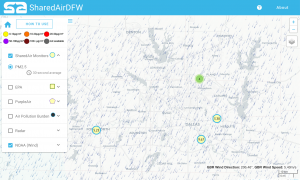
The Menu gives you a choice of three different PM monitor networks to look at: SharedAirDFW, the EPA, and Purple Air. You can look at them one at a time or all at once.
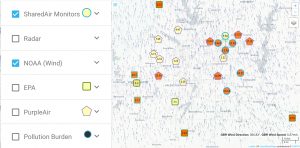
The menu also allows you to see where all the major air pollution permits are located in the City of Dallas. Click on the black dot and it reveals the name of the air pollution permit holder as well as the volume of pollution in tons per year reported in 2018 (the last fully reported year). We only have this mapped inventory of air polluters because of the Paul Quinn College report “Poisoned by Zip Code.” The City of Dallas has no such inventory or map.
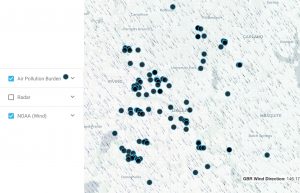
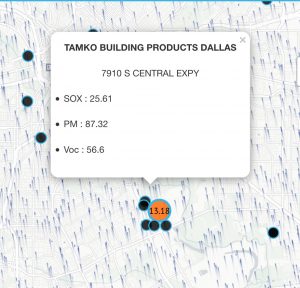
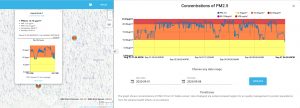
Joppa Air Monitor Already Providing Evidence of Why It’s Needed
Since it began collecting data on the afternoon of August 31st, the Joppa Zion Mothership monitor has consistently recorded the highest average levels of PM among all the deployed SharedAirDFW monitors, as well as all EPA and Purple Air monitors in DFW. These bar charts show the level of PM recorded from most of the current SharedAirDFW network monitors from 8/31/20 to 9/14/20. They’re all accessible to the public through the site.

A New Era for DFW Air Quality and Downwinders at Risk
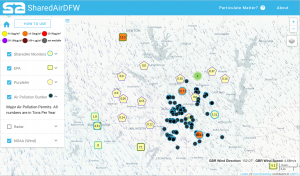
The SharedAirDFW network map displaying monitors from all three monitor networks and major Dallas air polluters identified.
The debut of the SharedAirDFW Network means
21st Century air monitoring finally arrives in North Texas
After three years, and many thousands of hours and dollars, citizens have their own
regional air quality monitoring system.
It’s easy to use, operates in real time, and its monitors are being put where the pollution burdens are greatest.
The Joppa Zion Mothership Monitor: on the Network’s digital map and on its pole after deployment.
Since operation began 8/31, it’s consistently shown higher levels of PM air pollution than other monitors in Dallas.
By January they’ll be 11 more monitors joining it in the Freedman-founded community.
A three-year high-tech collaboration between the University of Texas at Dallas, Downwinders at Risk, the City of Plano, Dallas County, Dallas College, and Paul Quinn College came to fruition today with the official debut of the the SharedAirDFW Network – online, and with an outpost in one of the most polluted neighborhoods in North Texas.
It becomes the first and only regional “hyper-local” air monitoring network in Texas and one of the only ones being built by any US city.
“This network is the purest, most dramatic expression of our 26-year old goal to provide citizens with the tools government won’t,” said Downwinders Director Jim Schermbeck, who’s helped shepherd the Network since it was a National Science Foundation grant runner-up in 2017. “We see SharedAirDFW’s debut as the public health equivalent of turning on electric streetlights for the first time at the turn of the 20th Century. We’re building a utility – the full impact of which won’t be realized for years.”

Dave Dabadeen, Kevin Owen, and Jay Smith – our monitor installation team, deploying one of 11 solar powered satellite monitors in Joppa.
Debuting with eight Particulate Matter (PM) air pollution monitors located from Richardson to Southern Dallas and Mesquite to Fort Worth, the network is scheduled to install over 100 more in the next 12-24 months, including blanketing Dallas neighborhoods whose residents say they’re already breathing bad air but have no way to prove it.
In the last decade published research on the human health effects of exposure to Particulate Matter air pollution has linked it to a variety of illnesses and diseases, including developmental impacts such as Autism, Parkinson’s, Dementia, and IQ loss. These effects have been documented at exposure levels well below U.S. EPA regulatory limits.
All the monitors in the network were built at the Physics Laboratory at the University of Texas at Dallas campus in Richardson. They’re being distributed to members either in clusters of 11, with one larger hard-wired “Mothership” accompanying ten smaller solar-powered ones or the Mothership as its own stand alone unit.
ALL DFW PM MONITORS DISPLAYED ON A SINGLE MAP
PM Air pollution data collected from those monitors, along with information from EPA and DFW Purple Air monitors, are displayed in real time on a digital map accessible to anyone online at www.sharedairdfw.com. For the first time, a single website displays all the online monitors networks collecting PM air pollution data in North Texas on the same map. Besides UTD, Downwinders at Risk, Dallas College, and Dallas County will be displaying the SharedairDFW map on their own websites.
Only Particulate Matter air pollution levels are shown by the SharedAirDFW map now but larger monitors will also be capturing Ozone, or Smog levels. At some point in the near future, that data will also begin to be displayed on the Network map.
MAPPING OF MAJOR POLLUTERS
Also on display are the locations of the major air polluters in the City of Dallas, along with their self-reported pollution volumes – a first-ever inventory of Big D’s air polluters that no level of government currently provides.
MANY MORE M ONITORS IN MANY MORE PLACES
ONITORS IN MANY MORE PLACES
Currently there are only six EPA monitors for Particulate Matter Air pollution in all of North Texas, and only 12 Purple Air monitors online. With the ability to saturate neighborhoods with almost a dozen monitors apiece, SharedAirDFW allows residents, researchers, and policymakers to better pinpoint pollution plumes and health risks.
REAL TIME DATA
For the first time there’s a way for DFW residents get air quality information in real time instead of waiting for up to two or three hours at government monitor sites. The SharedAirDFW monitors display their readings every 30 seconds, 24 hours a day.
AN EMPHASIS ON ENVIRONMENTAL JUSTICE
For the first time there’s year-round, calibrated air quality data being collected in Dallas’ most polluted neighborhood – the Joppa community in Southern Dallas along the Trinity River. The “Joppa Zion Mothership” – named for the adjacent Church – began transmitting on Monday August 31st. It’s linked to two additional “satellite” monitors that began transmitting this last weekend. By January they’ll be 11 monitors in Joppa, making it the most densely monitored neighborhood not just in Dallas, but all of Texas.
Joppa’s monitors are the first of 33 air monitors Downwinders at Rik is deploying in so-called “fence line” locations. After installation in Joppa is completed, another 11 will be installed in West Dallas, and then in and around Midlothian as well.
In the two weeks since the first Joppa monitor was installed, it’s consistently recorded higher levels of PM pollution than other monitors in the SharedAirDFW network as well as local EPA and Purple Air monitors. Schermbeck said those results vindicate the decision to locate monitors in predominantly Black and Brown neighborhoods disproportionately burdened by their proximity to industrial polluters. “Our monitors are going where people are most harmed by air pollution, but least able to do something about it.”
PM Pollution and COVID
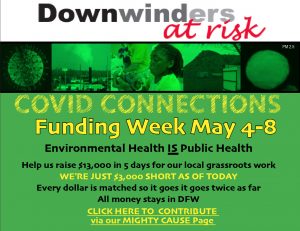
The Massachusetts-based Peace Development Fund has chosen to spotlight the COVID-connected work of
Downwinders at Risk and 12 other groups
across the country this week in order to help raise funds for that work.
As of late last night successfully met our original goal of $10,000. THANK YOU. So now we’re setting our sights on trying to raise an additional $3,000 by Friday. All of this money goes to local DFW program work in front line communities that are most vulnerable to
COVID infection.
Help us help more people.
CONTRIBUTE HERE
Thanks
______________________________________
COVID Connects:
Particulate Matter Air Pollution
to Increased Risk of Disease
What is It?
You’ve heard of the dangers of second-hand smoke? PM is industrial second-hand smoke.
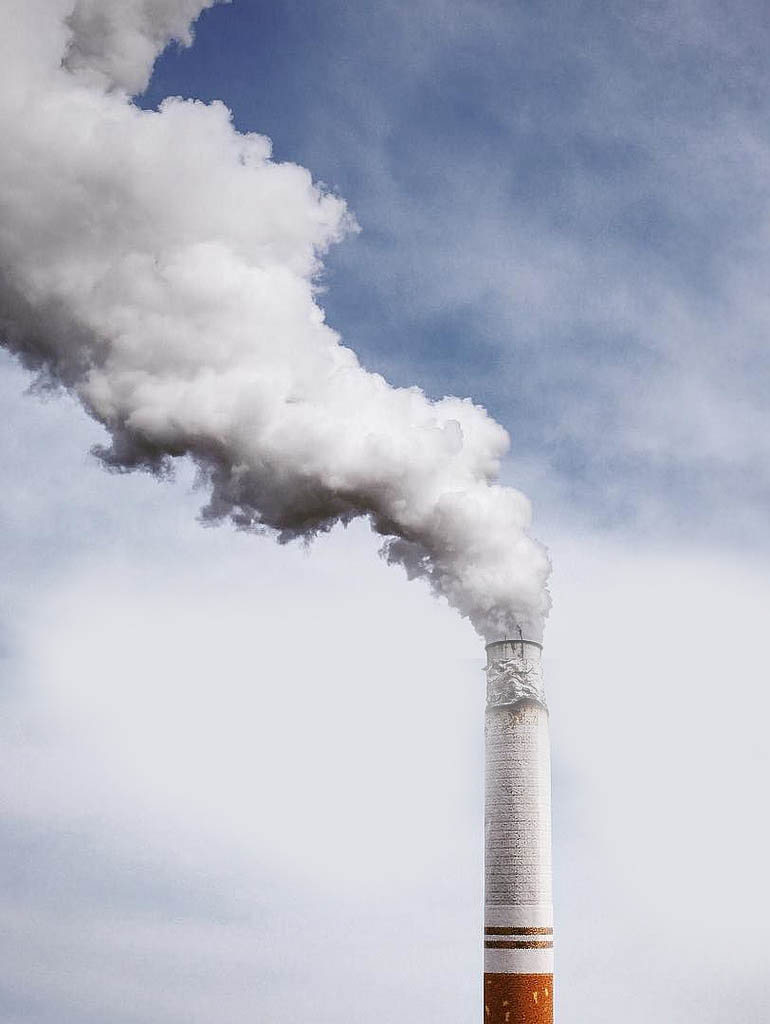 Research over the last decade connects PM pollution with not just lung and coronary diseases, but IQ loss, Autism, Dementia, Parkinson’s Disease, Diabetes, Immune-Deficiency, depression, and blindness. Research also shows Black and Brown residents are exposed to more PM pollution and at higher levels than most of their white peers.
Research over the last decade connects PM pollution with not just lung and coronary diseases, but IQ loss, Autism, Dementia, Parkinson’s Disease, Diabetes, Immune-Deficiency, depression, and blindness. Research also shows Black and Brown residents are exposed to more PM pollution and at higher levels than most of their white peers.re-thinking freeways. We’re in the weeds with neighborhood groups plotting new land use plans separating PM sources from people, or eliminating them altogether. In essence, we’re conducting an anti-smoking campaign aimed at machines.
Why Do It?
Sources of PM pollution are controlled by local gov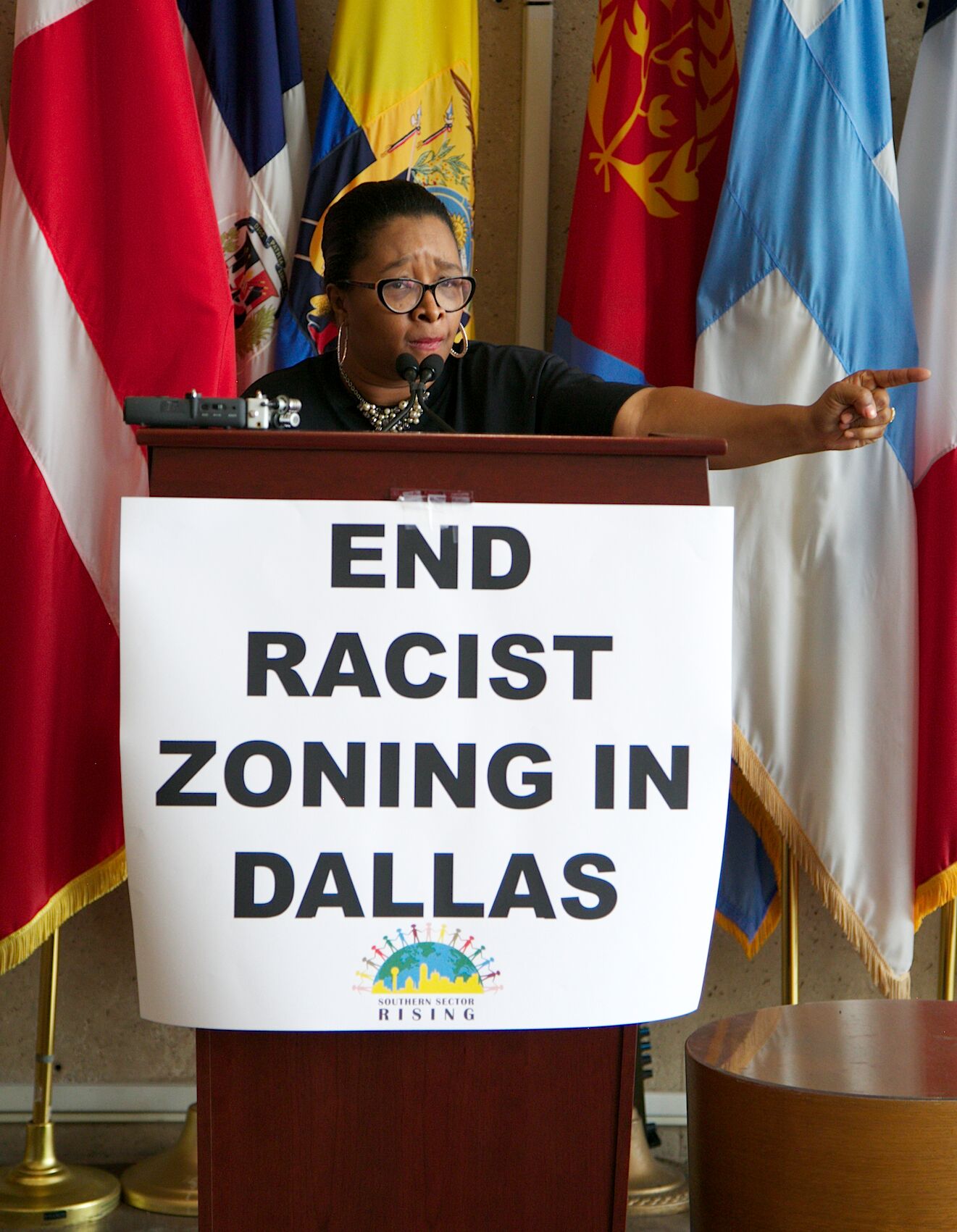 ernments through zoning and other municipal and county policies. As a local group, North Texas is where Downwinders is most effective in making change.
ernments through zoning and other municipal and county policies. As a local group, North Texas is where Downwinders is most effective in making change.
After the 2016 presidential election it was clear we couldn’t make progress on DFW chronic smog without good faith partners at EPA. So we turned our attention to addressing the most insidious air pollutant that can be controlled by local action. We found we could have a big impact on how these very small toxic particles are affecting DFW residents.
What’s the COVID Connection?
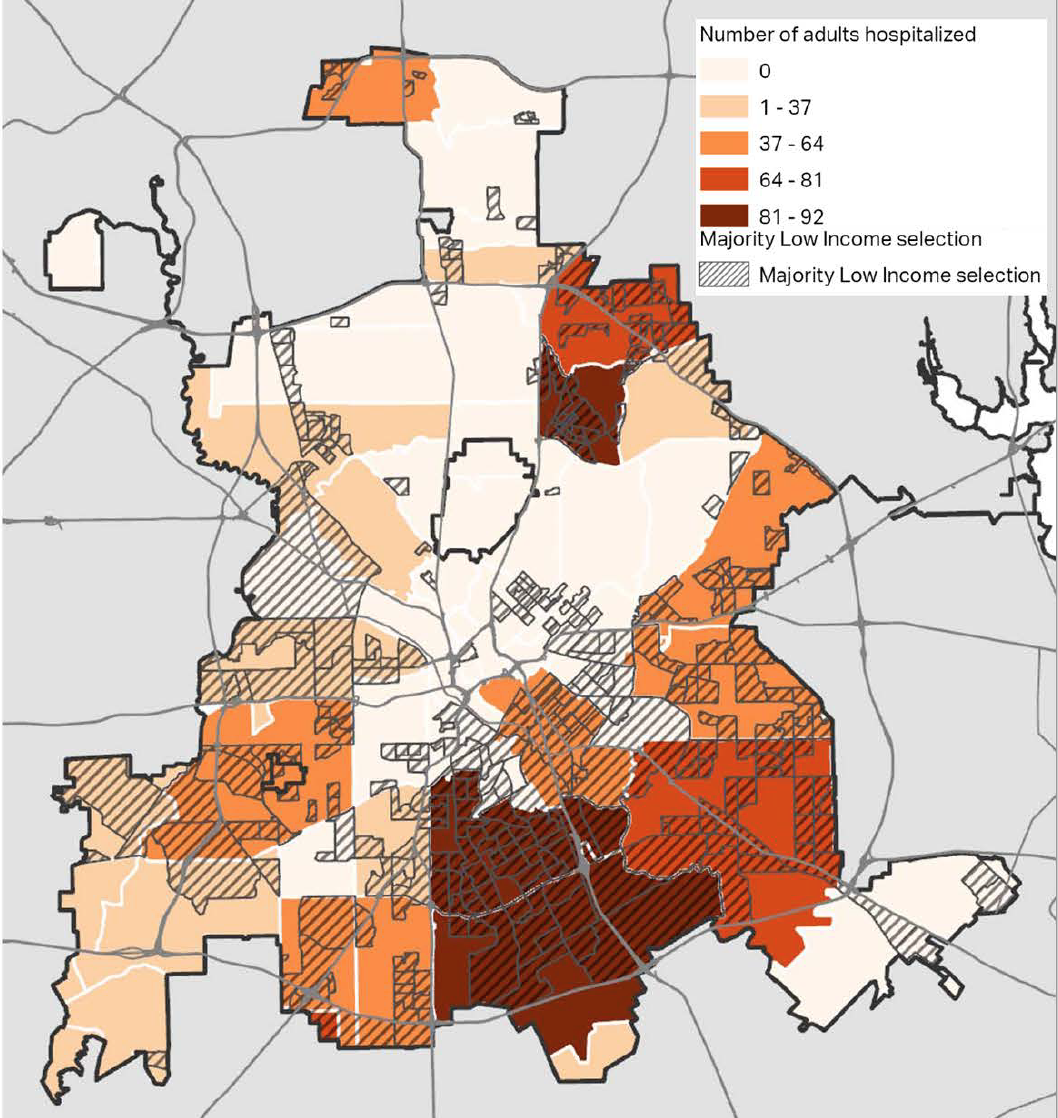
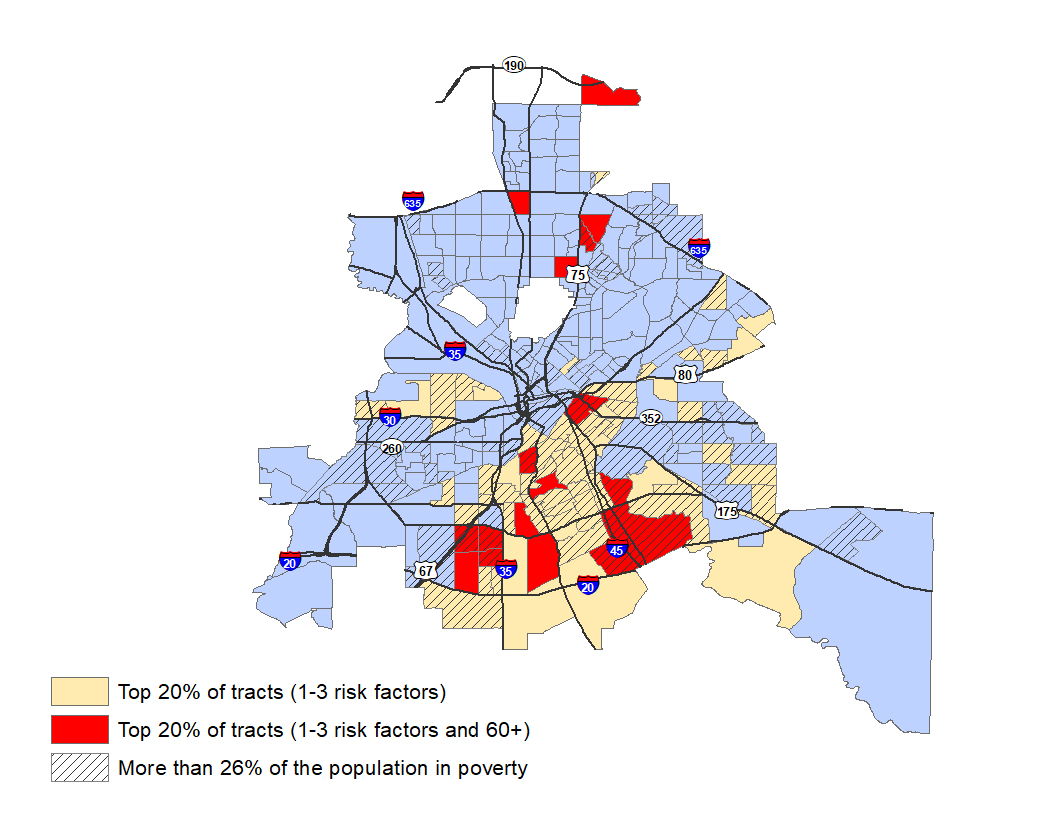
STATUS?
Since 2017 Downwinders has purchased five portable Aeroqual PM 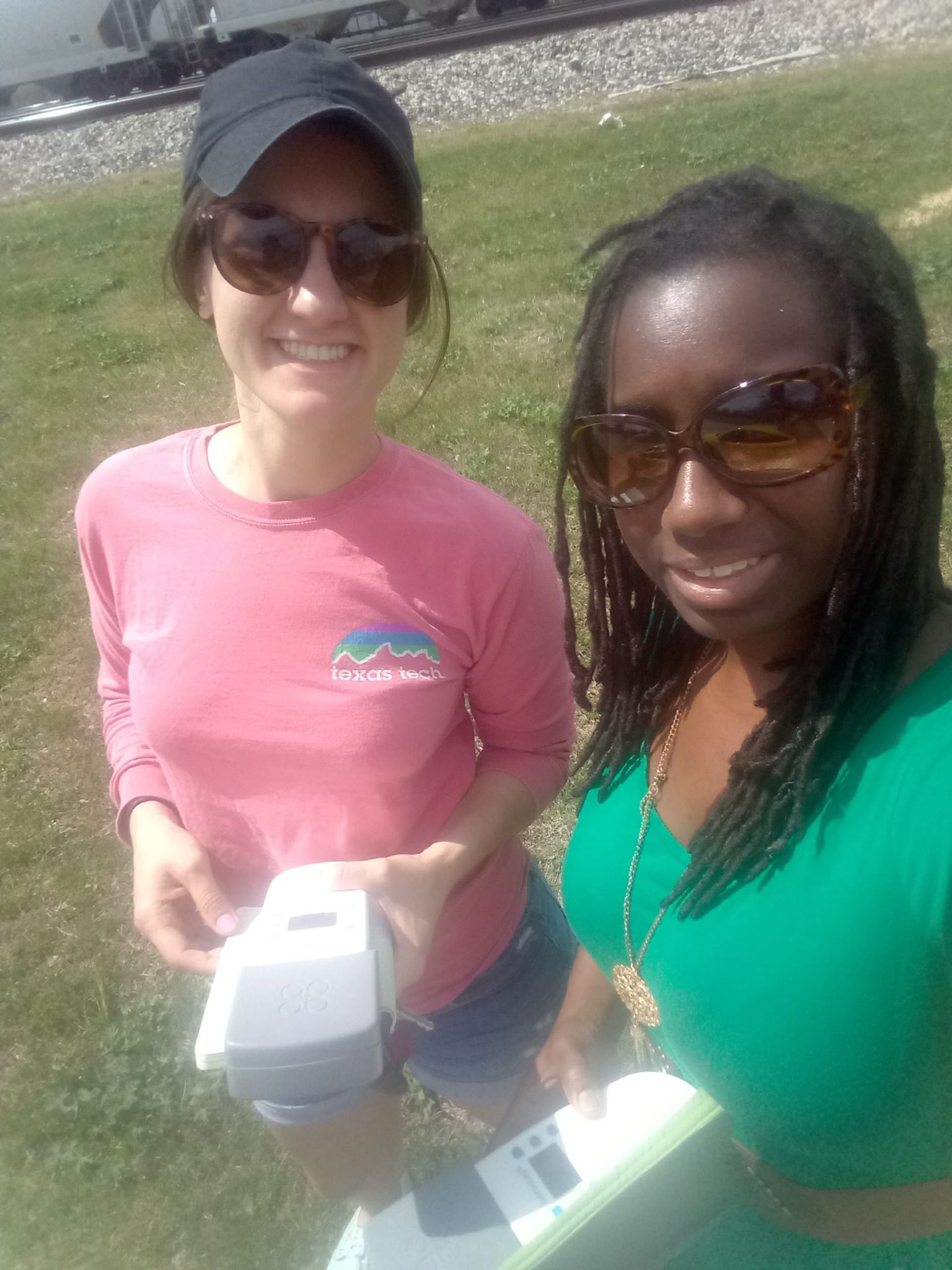 monitors that have been used to track PM Air pollution in DFW and identify hot spots. These portable monitors were the first to record PM levels in the Joppa community in Dallas and the Shingle Mountain illegal dump. We also offer free training in how to use these monitors.With UTD and others, Downwinders is building a 100 + PM monitor network for DFW to track the pollutant in real time across the region.
monitors that have been used to track PM Air pollution in DFW and identify hot spots. These portable monitors were the first to record PM levels in the Joppa community in Dallas and the Shingle Mountain illegal dump. We also offer free training in how to use these monitors.With UTD and others, Downwinders is building a 100 + PM monitor network for DFW to track the pollutant in real time across the region.
Dallas’ climate plan sets goals for electrification of the DART bus fleet by 2040 but other cities are moving faster.
For the last three years debate over the siting of proposed new batch plants has raised the profile of Particulate Matter at Dallas City Hall and around North Texas.
COVID CONNECTIONS
Downwinders At Risk was already dedicated to fighting for environmental health in North Texas before the COVID virus hit.
Focusing on harmful Particulate Matter, we were already supporting grassroots efforts to reduce the air pollution burdens in predominantly Black and Brown neighborhoods.
We were already building out local capacity to monitor DFW air pollution and advocating an increased role for local cities and counties to protect their residents from environmental health threats.
All of that work was important before March. It’s become more important since then. But our responsibilities on the ground are outstripping our ability to support them adequately. Like other non-profits, the virus has made it harder to do even the simple things.
This week you can help provide some relief.
The Peace Development Fund has chosen to spotlight the COVID-connected work Downwinders is doing, along with that of 12 other grassroots groups across the country to help supplement their budgets during the crisis. The Fund and generous donors are matching every dollar we raise this week up to $10,000 – that’s a $20,00,000 grant on the line.
We have until Friday to raise the $10,000.
Beginning today and continuing thru Tuesday the 5th at Midnight you can help us meet this goal by contributing via our North Texas Giving Day Page.
Then Wednesday thru Friday the Development Fund has its own Downwinders Mighty Cause pay portal you can also use.
We’re using each day this week to show how our various pieces of program work is more relevant than ever before. Today it’s an update on our ambitious new DFW air monitoring network – SHAREDAIRSDFW.
We know everyone is having a hard time, but with the Development Fund matching your dollars, you can make whatever contribution you give go twice as far to benefit those at highest risk.
Thanks for your support,
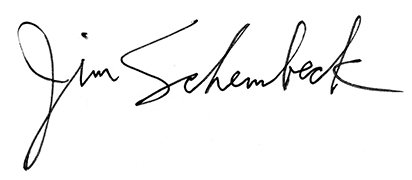

Evelyn Mayo, Chair
COVID Connects:
Vulnerable Communities to the Need
for Better Air Pollution Monitoring
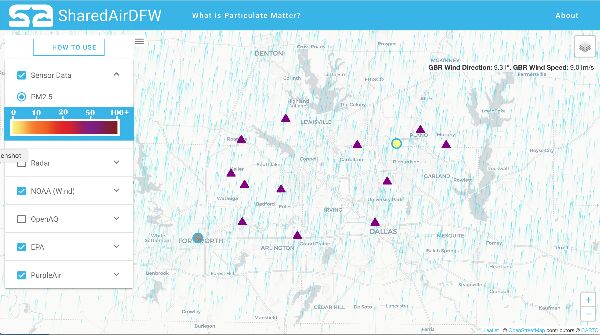
A screenshot of the SHAREDAIRDFW network map being assembled by UTD students and Downwinders at Risk. This map will soon be available at websites hosted by UTD, Dallas County and Downwinders, Only two of the over 100 new monitors are installed (dots) but more are on their way.
What is It?
The SHAREDAIRDFW community air quality monitoring network. 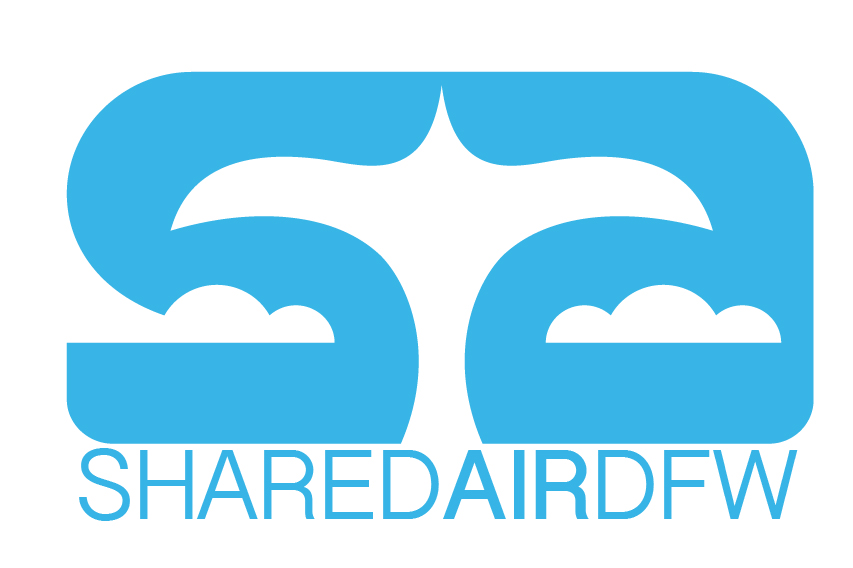 With its partners at UTD, Downwinders is building a new air monitoring network for DFW that will provide real time information from over 100 locations, including industrial hot spots in Joppa, West Dallas and Midlothian.
With its partners at UTD, Downwinders is building a new air monitoring network for DFW that will provide real time information from over 100 locations, including industrial hot spots in Joppa, West Dallas and Midlothian.
Why Do It?
Dallas County’s 2.7 million residents currently share only one EPA 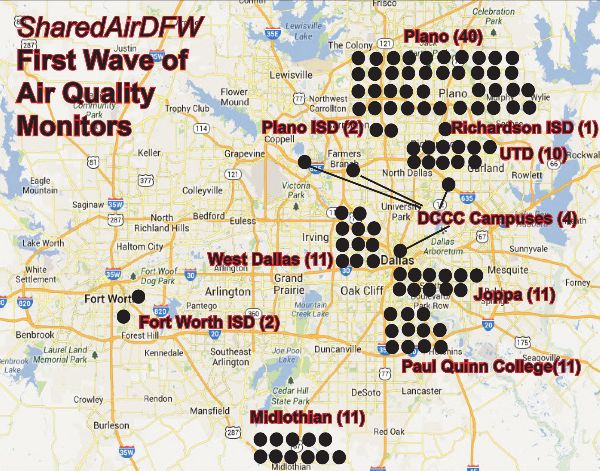 Particulate Matter air pollution monitor, north of downtown. Tarrant County has two and Denton County one. These monitors only reflect very local conditions and don’t reveal pollution levels in “frontline” neighborhoods where industry operates next to homes.
Particulate Matter air pollution monitor, north of downtown. Tarrant County has two and Denton County one. These monitors only reflect very local conditions and don’t reveal pollution levels in “frontline” neighborhoods where industry operates next to homes.
Making pollution burdens more equitable across racial and class lines requires identifying, measuring, and mapping those burdens: “You can’t fix what you don’t measure.” The SHAREDAIRDFW network is the first attempt to permanently map air pollution burdens across North Texas and make that information easily accessible to the public 24/7.Dallas County’s 2.7 million residents currently share only one EPA Particulate Matter air pollution monitor, north of downtown. Tarrant County has two and Denton County one. These monitors only reflect very local conditions and don’t reveal pollution levels in “frontline” neighborhoods where industry operates next to homes.
Making pollution burdens more equitable across racial and class lines requires identifying, measuring, and mapping those burdens: “You can’t fix what you don’t measure.” The SHAREDAIRDFW network is the first attempt to permanently map air pollution burdens across North Texas and make that information easily accessible to the public 24/7.
What’s the COVID Connection?
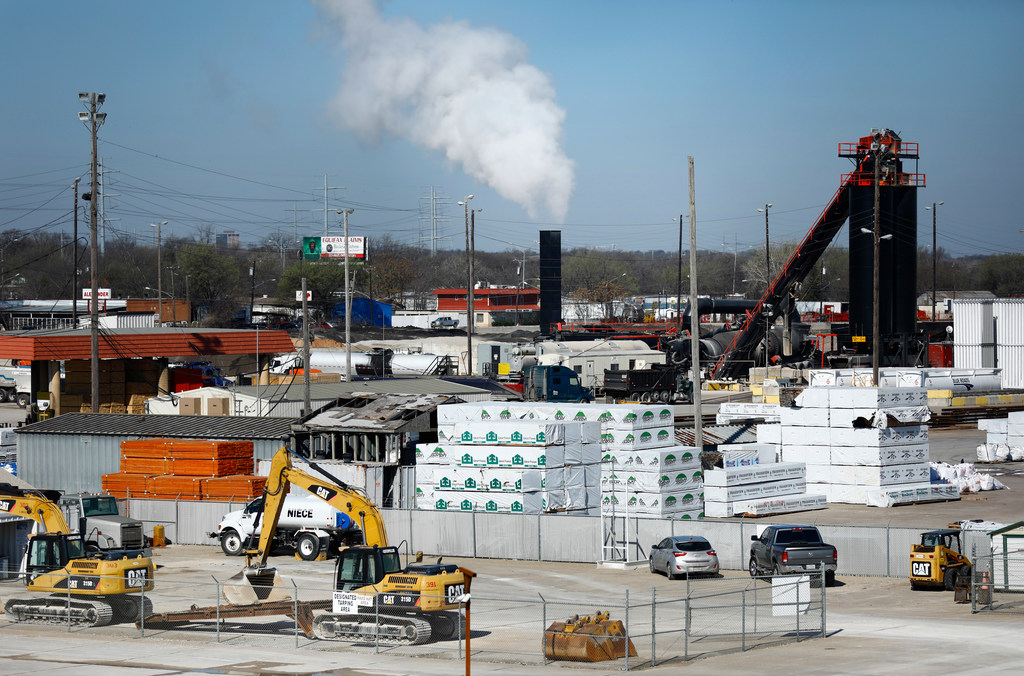
Research being done during the COVID pandemic concludes those living with the highest air pollution burdens are among the most vulnerable to being infected and dying from it. Specifically there seems to be a connection between a person’s exposure to Particulate Matter and Nitrogen Oxide air pollutants and the likelihood of contracting COVID. Past studies from the SARS epidemic also point to a strong link between exposure to air pollution and vulnerability to illness.By mapping where the heaviest air pollution burdens are, we can avoid adding to that burden and pursue policies targeting pollution decreases. We can begin to reverse the circumstances that makes the most pollution-impacted neighborhoods the most vulnerable to disease.
STATUS?
Via teleconferencing, UTD students are finishing up the digital map the Network 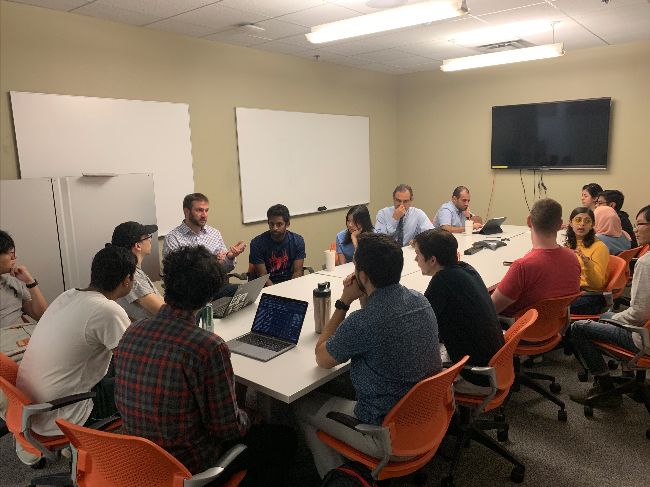 will use to display its real time air quality information. This map is meant to display not only the levels recorded by our own fleet of monitors, but easy access to the handful of EPA and Purple Air monitors in DFW as well.
will use to display its real time air quality information. This map is meant to display not only the levels recorded by our own fleet of monitors, but easy access to the handful of EPA and Purple Air monitors in DFW as well.
The map will be hosted on websites hosted by UTD, Dallas County and Downwinders.The first community monitors are slated for the former Freedman’s town of Joppa, where Downwinders bought a utility pole for the installation of the larger Mothership monitor. We’ve got a contract for Internet service and are now trying to tie down electrical power.
After a planned community meeting in March was canceled, we’re now gearing back up to find hosts for all ten “satellite” monitors. We hope to be able to begin operat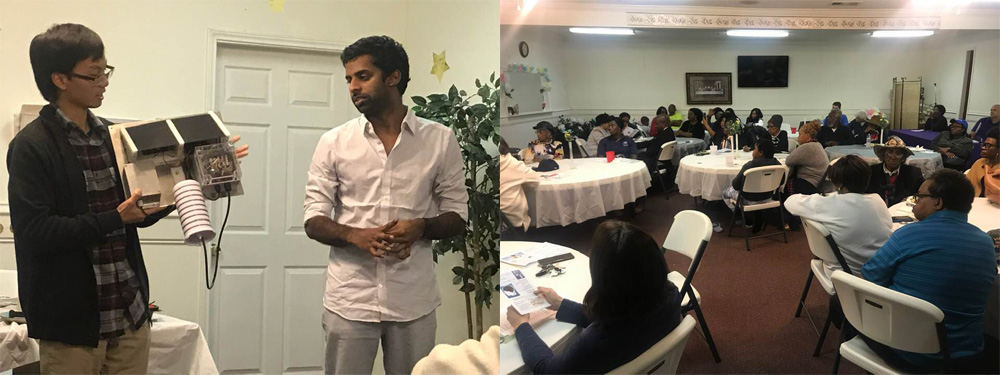 ion this summer.Once we’re up and running in Joppa, West Dallas is next and then Midlothian. In all Downwiwnders will be responsible for 33 of the over 100
ion this summer.Once we’re up and running in Joppa, West Dallas is next and then Midlothian. In all Downwiwnders will be responsible for 33 of the over 100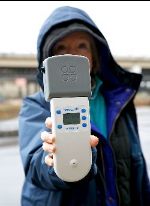 network monitors going up as part of the first wave installation.
network monitors going up as part of the first wave installation.
……MEANWHILE, Downwinders is using its portable monitors to record air quality in front line neighborhoods during the shelter-in-place periods so we’ll have a baseline for what cleaner air looks like.
How the Dallas Climate Plan Baits and Switches on Air Pollution

A little after 5 pm Monday February 3rd, the Office of Environmental Quality and Sustainability (OEQS) at Dallas City Hall released its draft recommendations for the city’s climate “action” plan. There are 93 “action items” including transportation, buildings, green spaces, water management, solid waste, and urban agriculture. Most are without imagination or timelines, meaning that even the most milk toast-like recommendations being made will have to be fought for tooth and nail to be done in a timely manner.
Like the department that generated them, the list of recommendations is effusive about stormwater management and tree-planting and silent on more challenging issues such as inequitable pollution burdens and the City’s own reliance on natural gas. It once again puts the spotlight on the lack of any environmental health expertise at Dallas City Hall in the decision-making process. When Dallas OEQS staff talk about the environment, what they really mean is “conservation” – a definition that’s been obsolete since at least the 1970’s.
There’s no better example of how this tunnel vision affects policy than OEQS staff invoking DFW’s chronically poor air quality (i.e. an environmental health problem) to sell the need for its Climate Plan…only to see the actual Plan ignore poor air quality as a serious health issue that could use some innovative thinking.
For over a year now, anytime you saw a Climate Plan presentation by Dallas OEQS staff, it always cited DFW’s smog problem as something that would only get worse as the climate crisis played out. “Everyone here is probably aware of DFW’s longtime air quality problems” or some approximate was the standard riff. And of course, everybody was. Heads nodded. Audience members were sometimes asked if they knew anyone with asthma and hands immediately shot up. That was the point. The selling point.
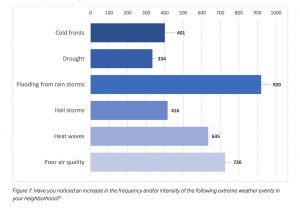 Because, until recently at least, the abstract nature of “the climate crisis” made it difficult to get people excited about the idea of a plan. Staff/Consultants needed a hook. And that hook was something everyone could relate to and probably already knew about: DFW’s three decades of violating the Clean Air Act. If you look at the results of the Ctiy’s online survey asking about frequency or intensity of climate change effects, “Poor Air Quality” was the second most cited concern. Among the City’s own handpicked crew of “stakeholders” advisors, it tied for first, along with buildings/energy use, getting more votes than parks, “nature-based approaches,” and renewable energy.
Because, until recently at least, the abstract nature of “the climate crisis” made it difficult to get people excited about the idea of a plan. Staff/Consultants needed a hook. And that hook was something everyone could relate to and probably already knew about: DFW’s three decades of violating the Clean Air Act. If you look at the results of the Ctiy’s online survey asking about frequency or intensity of climate change effects, “Poor Air Quality” was the second most cited concern. Among the City’s own handpicked crew of “stakeholders” advisors, it tied for first, along with buildings/energy use, getting more votes than parks, “nature-based approaches,” and renewable energy.
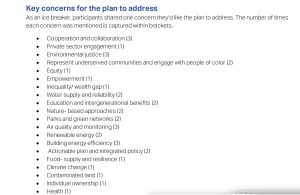
And yet, in those same City Staff presentations that highlighted poor air quality as a reason to have a Climate Plan, air quality itself was completely absent in the staff’s list of anticipated recommendations. It wasn’t that they just didn’t have much to say. They had nothing to say. There wasn’t even a category for air quality.
So Downwinders complained. Loudly. Staff and consultants sprang into action and came up with a category of recommendations officially called…“Other,” the theme of which was “air quality standards” and “public education.” Opportunities cited included “location-specific initiatives (e.g. downtown)” and “Programs targeted outdoor workers (e.g. Landscapers, construction workers).”
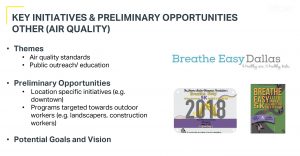 So sure, we have a chronic air pollution problem that warrants a $500,000 consultancy fee to construct a plan, but in that plan we’re only going to continue to inform people of that problem and maybe do some kind of vague thing relating to the poor souls who work outside (limit hours, hand-out free oxygen, help find new employment, or maybe free health check-ups? Doesn’t give a hint). By the way, only the public education part of that slide made it to last Monday. Construction workers and landscapers are still up a creek.
So sure, we have a chronic air pollution problem that warrants a $500,000 consultancy fee to construct a plan, but in that plan we’re only going to continue to inform people of that problem and maybe do some kind of vague thing relating to the poor souls who work outside (limit hours, hand-out free oxygen, help find new employment, or maybe free health check-ups? Doesn’t give a hint). By the way, only the public education part of that slide made it to last Monday. Construction workers and landscapers are still up a creek.
Along with those snippets of text on the “Other” slide were large color pictures of the “Breathe Easy” 5K run sponsored by The Jerome Alston Memorial Foundation in May…during Ozone Season. We’ll give the City staff credit. In terms of public education, there might not be a better way to personalize the seriousness of DFW’s air pollution problem than having North Texas smog cause an emergency asthma attack while you’re running in it. But liability could be an issue.
As late as the final round of public meetings last Fall, staff still didn’t have an “Air Quality” category but said they would have “something” when the plan was published.
Turns out “something” looks a lot like nothing.
Among the 93 “actions” listed in the Plan’s draft, the category of Solid Waste gets nine recommendations. Water Resources 15. Urban Ag 14. The brand new category of “Air Quality” has four – the fewest of any category in the plan. It’s practically stamping “Last-Minute Desperation” on the whole subject.
And tell us if any of these recommendations sound like anything you might have already heard about…
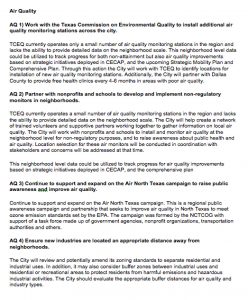
Let’s take them from the top.
The very first thing out of the gate, the lead-off, sexiest, out-of-the-box recommendation for improving air quality is…. somehow talk the State into adding more obsolete, state-run air monitors at some unspecified time in the future.
If you can, forget that the State environmental agency – the Texas Commission on Environmental Quality (TCEQ) – is a model for the Trump Administration. Forget that its official position is that smog is waaaaay overrated as a health threat. In other words, forget that this is akin to hiring Charlie Sheen to babysit your only child.
It’s not the baked-in, in-your-face cynicism of City staff knowing the state has every reason not to do this that’s so offensive. It’s the same cynicism applied to knowing full well what will happen even if the state says yes to the request: no real improvement in local information about air quality. Those state monitors are big, slow, and sparse. They run two hours or more behind real time. They’re hard to find online. They’re needlessly expensive and take up lots of real estate that has to be purchased. Their placement is decided by TCEQ and city staff, not the communities most in need of them. There is no stated OEQS goal for the number of monitors to acquire, or suggestions about where new monitors should be. No language in the recommendation about wanting real time monitoring or more modern equipment. It’s just an expansion of an already-obsolete system the state only runs because federal law requires them to (for now).
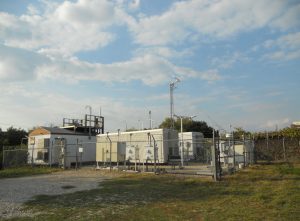
OEQS wants more of these lumbering and obsolete monitors from the state.
So let’s say the City talks the state into doubling the number of state PM 2.5 monitors in Dallas. Victory! The discussion will then be where to place the second slow, hard-to-find PM monitor for all of Dallas County’s 2.5 million residents.
Left unsaid in this recommendation is something we already know. For a year now Staff has tried to move that single Dallas County PM monitor located on Hinton Street north of Downtown to somewhere in Southern Dallas. Apparently the state has made that hard-to-impossible and so for the purposes of having something, anything, to recommend for this climate plan, staff recommends more monitors – knowing there’s a snowball chance in Hell of getting them. It’s the perfect bureaucratic out.
Most importantly the City remains a spectator to the reporting to its residents of how bad their air is. Its staff doesn’t have to make any environmental health judgments as they’re busy promoting tree planting. They leave that up to the people who couldn’t care less about how much pollution you’re breathing.
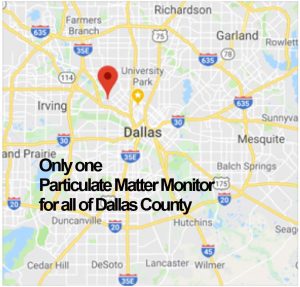
In the wake of recent Gulf Coast chemical plant accidents, the TCEQ is under heavy criticism for its lack of current air monitoring technology. The system it operates in DFW hasn’t changed in over 20 years. TCEQ won’t even put an air monitor in the only DFW “non-attainment” county that doesn’t have one – Wise – where smog levels have been predicted to be even higher than in DFW proper.
Recommending a modest expansion of circa-1999 technology is the opposite of a “best practices” answer for our gap in local air quality knowledge. The most alarming thing about this recommendation is that it got made at all.
The one-liner stapled at the end about offering free health screenings “with Dallas County” (who’s already in the business) in “areas with poor air quality” is incredibly condescending. Here’s the ultimate “settlement house” approach to a social ill – addressing the symptoms but not the cause. “Well, we can’t do much to enforce code or keep those batch plants out of your backyard, but by God we’ll be around every 6 months to keep track of your asthma until you die from it.”
How does OEQS staff know where those “areas with poor air quality” are now unless they’re out monitoring them? Which they clearly do not want to do. Given there’s only one official PM monitor for all of Dallas County, how are they defining “areas with bad air?” If they’re making educated guesses where those “areas” are based on other factors besides monitoring, why not name those factors and the “areas?” OEQS goes out of its way to avoid using the words “environmental justice” even as it makes recommendations based on the concept.
Recommendation #2 – let’s build our own “non-regulatory” air monitoring network sometime in the unspecified future with unspecified non-profits and community partner volunteers and put an unspecified number of monitors in unspecified places, for which we unspecified criteria. And these monitors “could be used to “to track progress for air quality improvements based on strategic initiatives deployed in CECAP, and the comprehensive plan.”
This is actually a great idea. It’s such a great idea that a specified alliance of local governments, non-profits, and community partners are already doing it in specified locations with specified monitors. Their effort is about to deploy over 100 locally-built air monitors that will increase PM 2.5 monitoring in Dallas County by 4000%. It’s called the SharedAirDFW Community Air Quality Monitoring Network and the City of Dallas officially walked out of it last year over a public participation requirement and a desire to refrain from being the source of bad news about bad air.
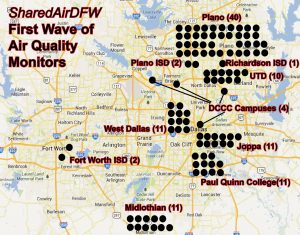
Dallas city staff is consistent in believing that telling you about air pollution is absolutely, positively necessary – they just want someone else to do it.
Having walked away from the SharedAirDFW network, OEQS set out to make one up of its own using the City Hall-friendly Nature Conservancy as its non-profit partner. The “Breath Easy” plan was to put 9-12 PM and smog monitors on the same number of DISD campuses, grow trees and implement anti-idling zones at those schools and see if asthma attacks/rates dropped in 24 months (2 growing cycles). Everyone seemed to agree how important a project this was and the city raised $500,000 or more to buy 12 very nice Aeroqual (Recommended by Downwinders since 2017!) air monitors. Everyone but the Dallas independent School District, who nixed the idea last summer. This detail somehow escaped the presentation staff gave to the City Council’s Quality of Life Committee on the Breath Easy project in September 2018.
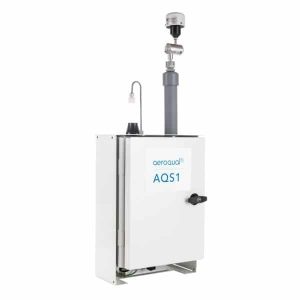
An Aeroqual stationary air monitor like the 12 Dallas owns…but isn’t using
So far the City of Dallas is 0 for 2 in making their own recommendation a reality when it had the chance. But wait! Remember those 12 monitors the City bought for the defunct Breathe Easy project? They’re just sitting somewhere. They’re already paid for but aren’t being used. OEQS could implement this recommendation of theirs on its own tomorrow if it wanted to by placing these 12 monitors in locations based on where the most industrial facilities are and where the most air pollution complaints come from. Overnight it could have its own fleet of “non-regulatory” monitors in the field, with all the benefits cited by staff.
But there’s no mention of those 12 monitors, or of the City Hall’s ability to accomplish this goal on its own, right now, without waiting. Because it doesn’t want to. It wants someone else to do it.
Recommendation #3 . It’s that forlorn public awareness recommendation showing up in the form of continued support for an ozone season air quality campaign run by a group that did its part to make smog an issue for years. There’s no harm to this but there’s also no help. This campaign will go on for as long as DFW is in violation of the Clean Air Act and doesn’t mention climate change.
Finally, there’s recommendation #4. Perhaps (but perhaps not) heavy industry that pollutes a lot shouldn’t be close to homes. This is coming straight-faced from a OEQS that’s approved the last four batch plants seeking permits to set-up shop in Joppa and the South Central Corridor…next to homes. Do as we recommend, not as we actually, you know, do.
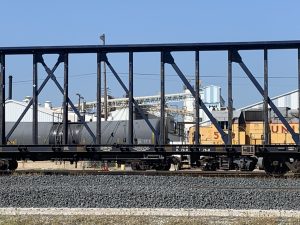
The TAMKO asphalt shingles plant and multiple diesel locomotives operate next to Austin’s asphalt batch plant…and residents in Joppa
When it says the City will review zoning, that’s not a special environmental health screening of sites. It’s just part of upcoming land use planning processes that will already be used to re-examine all zoning on a neighborhood-by-neighborhood level. They’re riding coat tails. The OEQS doesn’t make recommendations about suggested buffer zones, where those zones should be, or what criteria the city should use in pursuing buffer zones. And it doesn’t even say the City’s neighborhoods need any buffer zones between homes and industries at all, just that it may want to consider them at an unspecified time by an unspecified body for unspecified neighborhoods. Have we mentioned the staff at City Hall really really doesn’t like to deal with environmental health issues?
We get it. They had to have something or you’d be reading our criticism about the absence of ANY specific air quality recommendations, no matter how lame. And there are other items in other categories that will inevitably produce decreases in air pollution of all kinds – bus and vehicle fleet electrification being among the lowest-hanging fruit.
But City Hall’s cynical use of DFW’s air pollution problem to win support for a plan that ends up doing nothing about it directly makes these “Air Quality” recommendations particularly contemptuous.
What would more sincere “air quality” recommendations look like?
1. Acknowledging an historic imbalance in the air pollution burdens borne by Dallas neighborhoods and a commitment with a deadline to inventory the City’s air pollution threats by council district and zip code. You c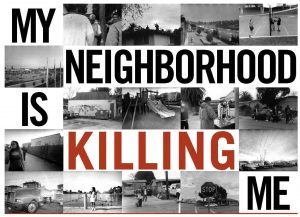 an’t fix what you don’t measure. Right now there’s no map of where concentrations of air pollution are in Dallas.
an’t fix what you don’t measure. Right now there’s no map of where concentrations of air pollution are in Dallas.
2. Acknowledging there’s no safe level of PM air pollution, i.e., no amount of exposure that isn’t capable of doing harm. Acknowledging People of Color are exposed to more, and higher levels of PM pollution than their white peers. These conclusions, supported by a multitude of good studies, including ones from EPA, are basic in prioritizing where to reduce air pollution in Dallas.
3. Recommendation to write an Environmental Equity Provision into City Code to discourage and prohibit siting new polluters in those zip codes hosting more permitted polluters than the citywide average, beginning in 2021.
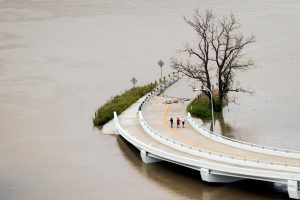 4. Recommendation to quit siting polluters in any floodplain beginning in 2021.
4. Recommendation to quit siting polluters in any floodplain beginning in 2021.
5. Recommend a 2025 deadline for the electrification of all railroad switch yard operations in Dallas.
6. Recommend 1500 foot buffer zones on either side of new major highways where homes, day care centers, and schools would be prohibited from locating. Applied to existing highways as uses within 1000 feet come up for new permits and zoning.

7. Recommend the immediate amortization and relocation of the GAF asphalt shingle factory in West Dallas and the TAMKO shingle factory in Joppa. These factories are among the City’s largest industrial polluters in Dallas, accounting for over 420 tons of air pollution in 2017 alone. They operate in the middle of dense urban residential areas populated primarily by People of Color. They need to be relocated elsewhere. Building new facilities will automatically trigger modern pollution controls requirements. They’ll be cleaner and doing business in a less harmful location.
8. Recommendation to rewrite city codes giving incentives for cleaner industries and more requirements for dirty ones.
9. Join UTD’s SharedAirDFW Community Air Monitoring Network – plug OEQS’ 12 unused monitors into the Network and begin to take responsibility for telling Dallas residents what their air quality actually is.
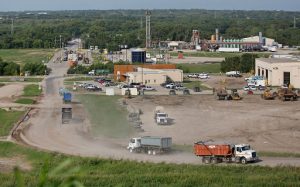 10. Acknowledge the conflict of interest the City has in producing and selling gas from its landfill recovery operation and commit to electrification of all city-owned vehicles by 2025. Dallas’ own city-run McCommas Bluff methane gas recovery facility is the fourth largest air polluter in Dallas, releasing over 160 tons of air pollution in 2017 alone. Recommend contracting only with electric vehicle fleets for additional services. Los Angeles recently committed to an all electric garbage truck fleet in five years, and Dallas could do the same – but it still wants to use its own landfill gas to power combustion vehicles.
10. Acknowledge the conflict of interest the City has in producing and selling gas from its landfill recovery operation and commit to electrification of all city-owned vehicles by 2025. Dallas’ own city-run McCommas Bluff methane gas recovery facility is the fourth largest air polluter in Dallas, releasing over 160 tons of air pollution in 2017 alone. Recommend contracting only with electric vehicle fleets for additional services. Los Angeles recently committed to an all electric garbage truck fleet in five years, and Dallas could do the same – but it still wants to use its own landfill gas to power combustion vehicles.
11. Implement stronger enforcement of the city air quality and nuisance ordinances, including hiring new staff and publicizing how to request an investigation.
12. Beginning in 2025 begin collecting municipal clean air mitigation fees of $50 a pound on permitted air pollution from major sources to incentivize pollution controls and pay for new staff. In 2017 such a fee would have collected over $1 million.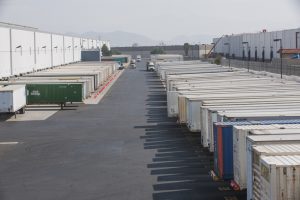
13. Implement no idling zones in all Dallas warehouse districts.
14. Recommend Low-Emission Zones in Downtown Dallas where combustion vehicles are banned or restricted, permanently or on a schedule. Consider expanding to other parts of Dallas such as Deep Ellum and Bishop Arts where congestion is already a problem.
15. Recommend PM pollution protection be designed into new bus shelters.
16. Recommend establishment of an Electric Bus Procurement Pool with DISD, DART, Trinity Metro, other area schools districts, and transit companies for cheaper purchases of electric buses.
17. Restoration of t he Dallas Environmental Health Commission.
he Dallas Environmental Health Commission.
18. Hiring a City of Dallas Environmental Health Scientist.
DFW does have a chronic bad air problem. The Climate Crisis will make it worse. It is a legitimate area of policy planning in any thoughtful, modern Climate Plan.
Just not this one.
Listen to Our New Chair Get Interviewed By D Magazine
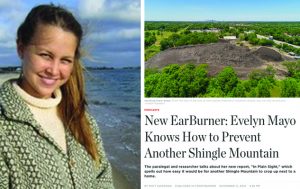
Downwinders at Risk’s new Chair Evelyn Mayo gets a huge shout out in D magazine’s popular online manifestation with her very own “Earburner” podcast.
D magazine reporter Matt Goodman and D Managing Editor Tim Rogers interview Evy about her new report on Southern Dallas zoning for Legal Aid, her Roller Derby years in Singapore, and of course, Particulate Matter.
CLICK HERE to link to the podcast and learn more about one the new dynamic leaders of Downwinders at Risk.

/cloudfront-us-east-1.images.arcpublishing.com/dmn/KAAKWCLEMNCRXNYABMHB33CEPA.jpg)
